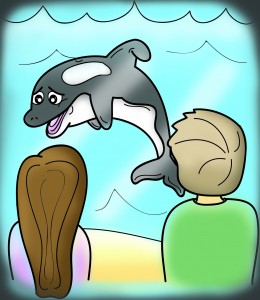By Henriikka Niemi
Staff Writer
Black and white majestic killer whales ranging from 16 to 23 feet jump through the air, perform tricks and splash water on the captivated crowd; this is the typical scene at the Shamu shows in any of the SeaWorld Parks in the United States.
In 2010, following the death of SeaWorld Orlando trainer Dawn Brancheau at the mouth of killer whale Tilikum, Gabriela Cowperthwaite set out to document what was really causing the aggression behind killer whales in captivity, which has led to numerous fatal incidents. Blackfish premiered in the summer of 2013 at the Sundance Film Festival and was released on Netflix and CNN in the fall.
The documentary portrays how SeaWorld captures killer whales from the wild, separating the babies from their mothers and often accidentally killing a few in the process, then takes them to SeaWorld facilities and trains them to put on a show. It focuses on the case of Tilikum, a male killer whale who has to date contributed to the death of three trainers, claiming the conditions the whales are kept in contributed to this aggression. A number of former SeaWorld trainers were interviewed.
“Killer whales swim 100 miles a day but in captivity they’re kept in basically a bathtub,” senior Lynnette Casillas said. “They should be wild and it would be a lot cooler to see a killer whale in person in the ocean rather than in a tank.”
SeaWorld Entertainment Inc. did not respond to multiple email requests for comment.
Coppell High School biology and aquatic science teacher Laronna Doggett graduated from Texas A&M University at Galveston with a degree in marine biology and marine fisheries. Doggett volunteered with the Texas Marine Mammal Stranding Network in Galveston, rehabilitating dolphins that were beached on the coast of Texas. She was originally inspired to become a marine biologist after visiting SeaWorld in the fourth grade.
In college, Doggett worked at SeaWorld San Antonio for a period of two weeks learning the ins and outs of each department. She spent time with the dolphins, penguins, white whales, seals, sea lions, beluga whales and killer whales.
“They do a lot of great things for the animals,” Doggett said. “The food that they feed them is better quality than we eat, and they make sure that they have a lot of interaction to keep them from being bored.”
Blackfish also touches on the harm killer whales can come to in captivity; most of the whales at SeaWorld have collapsed dorsal fins, shorter lifespans than their counterparts in the wild, are kept in small enclosures relative to their size and some, like Tilikum, sustain injuries at the hands of other whales.
“The whole reason why we have zoos, aquariums and places like SeaWorld is to educate the public,” Doggett said. “Without them we wouldn’t know as much about organisms that are not found in our backyard. Unfortunately, as a society we are selfish and unless we can see the animal and have a connection with it, we tend to not care about it.”
According to Blackfish, there has never been a documented case of a human fatality at the hands of a killer whale in the wild, whereas there have been multiple incidents at SeaWorld parks.
“A lot of that is human error. You have to remember that you’re working with wild animals,” Doggett said. “These are not domesticated dolphins or whales, even though they’re bred mostly in captivity. We get to a certain comfort level when we’re working with the animals and sometimes we forget that.”
In addition to putting on shows for the public, SeaWorld conducts research to learn about the animals’ genetics, behavior, how to treat them medically and even what problems they are facing in the wild. As a result of overfishing, noise pollution and oil spills, marine environments all over the world are being destroyed and species are being threatened as their habitats are being degraded. The information collected at SeaWorld and other marine parks can be instrumental to saving species that may be threatened or extinct in the future, and there is a very real possibility that killer whales could be added to the list.
According to Doggett, the size of the enclosure where killer whales are kept should be expanded and a natural bottom should be added to the tanks so that the whales and other animals can rub against the bottom, sloughing off dead skin. The biggest factor in this decision is funding as filtration systems, water, electricity to keep the water cold, food, vitamins, medicine, trainers and other facilities maintained at SeaWorld already likely add up to a huge bill.
The issue can also be traced to the suitability of killer whales to captivity. Killer whales are nicknamed “wolves of the sea,” because in the wild, a pack will surround a whale five or six times their size and kill it for food. With an obvious aggressive temperament, many argue that killer whales are not suited for captivity.
“I personally am not going to go to SeaWorld anymore, I don’t support them,” Casillas said. “I think everyone needs to be aware of what SeaWorld is doing and the comparison between killer whales in captivity and in the wild.”









